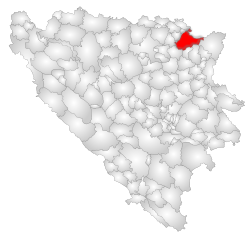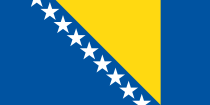Brčko District
| Brčko District Brčko Distrikt Брчко дистрикт |
|||
|---|---|---|---|
|
|||
 |
|||
| Coordinates: | |||
| Country | Bosnia and Herzegovina | ||
| Established by Final Arbitration Decision | March 5, 1999 | ||
| Government | |||
| - Mayor | Dragan Pajić | ||
| - President of the District Assembly | Mirsad Đapo | ||
| - International Supervisor | Raffi Gregorian | ||
| Area | |||
| - Total | 493 km2 (173 sq mi) | ||
| Population (1991) | |||
| - Total | 87,332 | ||
| Time zone | CET (UTC+1) | ||
| - Summer (DST) | CEST (UTC+2) | ||
| Postal code | 76100 | ||
| Area code(s) | (+387) 49 | ||
| Website | Official Web Site, Official District Assembly Website Official District Prosecutor Web Site |
||
Brčko District (Serbian,Bosnian and Croatian: Brčko distrikt Cyrillic: Брчко дистрикт) in northeastern Bosnia and Herzegovina is a neutral, self-governing administrative unit, under the sovereignty of the Bosnia and Herzegovina. It is formally part of both entities, the Republika Srpska, and the Federation of Bosnia and Herzegovina.
Contents |
History
Brčko District was established after an arbitration process undertaken by the High Representative for Bosnia and Herzegovina. According to Dayton Peace Accords however, the process could only arbitrate the disputed portion of the Inter-Entity Boundary Line (IEBL).[1] The Brčko District was formed of the entire territory of the former Brčko municipality, of which 48% (including Brčko city) was in the Republika Srpska, while 52% was in the Federation of Bosnia and Herzegovina. After the war, the EU has maintained a diplomatic peace-keeping presence in the area.
In 2006 under the Supervisory Order all "Entity legislation in Brčko District and the IEBL" were abolished. The ruling made by the Brčko Supervisor Susan Johnson abolishes all Entity Laws in the District also abolishes the Entity Border Line. The ruling makes the Laws of the District and the Laws of the State of Bosnia and Herzegovina (including the laws of the Socialist Republic of Bosnia and Herzegovina) paramount within the District.[2]
Brčko was the only element in the Dayton Peace Agreement which was not finalized. The arbitration agreement was finalized in April 1996 resulting in a "district" as mentioned above which was to be administrated by international representation with ambassador status.
The first Ambassador representing the District of Brčko arrived in June 1996. Prior to that time, the Organization for Security and Co-operation in Europe (OSCE) had a modest office headed by Randolph Hampton. During the interim time before the District of Brčko could be represented post arbitration agreement, local elections were held, humanitarian relief was provided with cooperation from USAID and ECHO.
Brčko continues to be a divided town which prior to the war in Bosnia (April 1992) was a city with Croats, Serbs and Bosniaks living together harmoniously.
Population
1971
74.771 total
- Bosniaks - 30,181 (40.36%)
- Croats - 24,925 (33.33%)
- Serbs - 17,709 (23.68%)
- Yugoslavs - 1,086 (1.45%)
- others - 870 (1.18%)
1991
Before the war the Municipality of Brčko had 87,332 inhabitants (1991 census), including:
1997
In 1997, population of the district territory numbered 33,623 inhabitants, including:
- Serbs: 18,193 (54.11%)
- Bosniaks: 10,569 (31.43%)
- Croats: 2,650 (7.88%)
Current population
There has not been an official census since 1991, though some have offered preliminary statistics.
In 2006, population of the district numbered 78,863 people, including:
- Serbs: 38,618 (46.55%)
- Bosniaks: 32,332 (43.95%)
- Croats: 7,919 (11.50%)
Government and politics
There are 29 seats in the Assembly of the Brčko District. The seats are divided as follows:[3]
By party:
- 6 Serbian Democratic Party
- 5 Social Democratic Party
- 4 Party of Democratic Action
- 3 Croatian Democratic Union
- 3 Party for Bosnia and Herzegovina
- 2 Alliance of Independent Social Democrats
- 2 Croatian Peasant Party
- 2 Socialist Party of the Republika Srpska
- 1 Democratic Party
- 1 Independent
By ethnicity:
By gender:
- 27 men
- 2 women
See also
- Bosnia and Herzegovina
- Subdivisions of Bosnia and Herzegovina
- Republika Srpska
- Federation of Bosnia and Herzegovina
External links
- Brčko District City portal
- Government of the Brčko District
- Assembly of the Brčko District
- History and Mandate of the OHR North/Brčko
- Brčko district map
References
- ↑ Dayton Agreement, Annex 2, Article V
- ↑ Supervisory Order Abolishes Entity Legislation, Ends Legal Significance of IEBL in Brčko District
- ↑ http://skupstinabd.ba/fajlovi/sala.pdf
|
||||||||||||||||||||||||||||||||||||||||||||||||||||||||||

